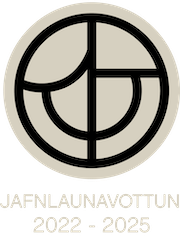Undirstöður landbúnaðarsamfélagsins. Fjölskyldan og heimilisbúskapur á Íslandi í upphafi 18. aldar - verkefni lokið
Fréttatilkynning verkefnisstjóra
Rannsókninni er ætlað að auka skilning okkar og þekkingu á félagsgerð Íslands við upphaf 18. aldar og grunnstofnunum hennar: fjölskyldunni, heimilinu og jörðinni. Við könnum gerð og hætti fjölskyldna, framleiðslu og tekjur heimilanna og samskipti leiguliða, jarðeigenda og annarra stétta. Við könnum einnig viðbrögð fjölskyldna við langvarandi harðindum um aldamótin 1700.
Rannsóknin er þverfagleg og lögð áhersla á samspil félagsgerðar, lífsháttta og umhverfis. Í því skyni er höfum við byggt upp gagnagrunn á landsvísu um fólksfjölda, heimili og býli, sem sækir gögn í manntal og kvikfjártal 1703 og jarðabók Árna og Páls 1702–1714. Gagnagrunnurinn er tengdur við ArcGIS hugbúnað til þess að auðvelda greiningu á gögnum frá landfræðilegu sjónarhorni.
Rannsókninni er ekki að fullu lokið en við væntum þess að hún muni greiða fyrir nýjum
skilningi á landbúnaðrsamfélagi fyrri tíma. Hún hefur þegar skilað margvíslegri nýrri
þekkingu um gerð og eignarhald á býlum, byggð og eyðibýli, samskipti stétta, heimilisbúskap,
lífskjör, fjölskylduhagi og framfærslukerfið. Eldri talnagögn hafa verið endurskoðuð og ný
búin til. Gagnagrunnurinn er sá fyrsti sinnar tegundar á Íslandi og gefur færi á að rannsaka
efniviðinn allt frá einstökum heimilum og býlum, til hreppa, sýslna og landsins alls.
Rannsóknin hefur verið lyftistöng fyrir hagnýtingu landupplýsingatækni í sagnfræði og lagt
þannig af mörkum til uppbyggingar innviða í hugvísindum. Gagnagrunnurinn er öflugt
rannsóknartæki sem verður öllum aðgengilegur að rannsókn lokinni.
English:
The project‘s aim is to provide a detailed analysis of the social and economic structures and
relationships of rural society in early 18th century Iceland with focus on three themes:
landownership and landlord-tenant relations, the household economy, and demographics on
households and families. We adopt an interdisciplinary approach and emphasize the
geographic dimensions of all the three themes. For that purpose, we have constructed a
comprehensive, national database on population, households and farms which is connected to
ArcGIS software that enables the use of Geographical Information System (GIS) technology.
Although research is not completed it has already produced new knowledge on the social
and economic structure and relationships in Icelandic society around 1700: the size, form and
ownership of landholdings, the household economy and living standards, family, households
and social relationships, the social support system, etc. Older statistics have been revised and
new ones been established. One of the unique qualities of the database is the possibility of
selecting different levels of aggregation, from national level down to individual farms.
The project has been pivotal in promoting GIS technology in historical research in Iceland
and made an important contribution to the research infrastructure in digital history. We have
established contact with the Digital Humanities Centre at the Faculty of Humanities, UI, and
look forward to cooperation on advancing the humanities research infractructure and
exploring new research possibilities. The project has twice received grants from RANNIS
Infrastructure Fund, in 2019 and 2022, which has been a great boost for the ongoing
improvement of the database. We have also been successful in recruiting students and number
of them has become acquainted to large data handling and processing and undertaken research
in their studies.
Information on how the results will be applied
The results will bring a new understanding of the structure and relationship of pre-industrial
rural society. The database will be accessible to researchers as well as the general public. We
stress that the database is a powerful research tool that has a great potential not only for
historians and social scientists but also geographers, biologist and other scientists. We also
see the database on the web as a great tool for the public to learn about people, places and
society in former times.
A list of the project’s outputs
Our plan is to use this year and the first months of 2023 to complete the project and deliver all
the tasks that were set out in the original research plan. This includes a website, the
completion of the database, two doctoral theses, an article in international journal by each
doctoral student, an anthology with the research results (provisionally titled Heimilið, býlið og
búskapurinn. Bændasamfélagið á Íslandi um aldamótin 1700), an article by Guðmundur and
Ólöf published in an international journal, and a web that gives access to the database.
The deliverables with milestones:
Milestones and finalization of the project 2022-2023
October 2019 Launch of the project website
March 2022 Finalization of the database
March 2022 Full draft of book chapters submitted
June 2022 Final draft of book chapters submitted to editors
September 2022 Final revision of book chapters. Proof-reading
October 2022 Submission of articles by Guðmundur and Ólöf to an international journal
November 2022 Publication of the book
November 2022 Launch of the project's web and access to database
Decenber 2023 Full draft of Óskar Guðlaugsson's thesis submitted to supervisor
January 2023 Full draft of Sigríður Jörundsdóttir's thesis submitted to supervisor
March 2023 Ph.D. theses submitted for doctoral defence
April 2023 Submission of articles by doctoral students to an international journal
Heiti verkefnis: Undirstöður
landbúnaðarsamfélagsins. Fjölskyldan og heimilisbúskapur á Íslandi í upphafi 18.
aldar / The pillars of rural society. Family and household economy in early eighteenth
century Iceland
Verkefnisstjóri: Guðmundur Jónsson, Háskóla Íslands
Tegund styrks: Verkefnisstyrkur
Styrktímabil: 2017-2019
Fjárhæð styrks: 43,98 millj. kr. alls
Tilvísunarnúmer Rannís: 174294


